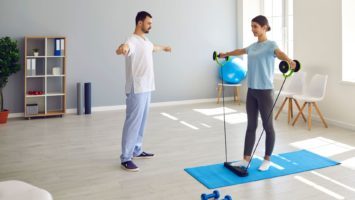
Exercise for Osteoporosis
Osteoporosis is a disease characterized by reduced bone mineral density and strength that is most common in older women with a slight bone structure. While there is no cure for osteoporosis, an exercise program may help people build and maintain their bone mass. In this article, we will discuss exercise for osteoporosis.
Individuals with osteoporosis have bone density in their hips, spine, or other bones that is more than 2.5 standard deviations below the average bone density for a healthy 30 year old of their same race and sex. Osteopenia refers to a bone density T score of 1 to 2.5 below the average for a healthy 30 year old of the same race and sex.
Osteoporosis is most common in White and Asian, post-menopausal women but can occur in younger people with eating disorders or due to other conditions.
While Osteoporosis and Osteopenia may not be curable, a structured exercise program can help slow prevent bone loss or even help you build and improve your bone density.
Can you improve osteoporosis with exercise?
Some, but not all people may be able to improve their bone density with an exercise program. Others may be able to prevent greater losses in bone density by starting an exercise program.
Whether or not you are able to improve osteoporosis depends on your age, exercise routine, race, bone structure, nutrition, medications, past diseases and overall health status.
Strength Training
Strength training can help improve bone density in both healthy people and in people with low bone density. To improve your bone density, you must choose exercises that stress your skeleton. For example, weight bearing exercises like dumbbell squats can help you build and maintain bone mass in your hips and spine. Push ups can help you build and maintain bone mass in your shoulders, elbows and wrists.
To get the benefits of strength training, aim to perform a full body, progressive strength training routine at least two times per week. Use compound, multi joint exercises instead of isolation exercises whenever possible to build stronger bones.
Some good exercises to use include squats, glute bridges, step ups, lunges, push ups, rows, pull ups, planks and bird dogs.
To really improve bone mass, aim to challenge yourself and build strength over time. Also aim to include some heavier exercises for 4 to 8 reps per set. Using heavier weights and lower reps will help you boost your bone mass more than just using lighter weights for more reps.
Using exercises that load the spine like squats and deadlifts can also really help improve bone mass by loading your skeleton.
If you need help, consult a qualified personal trainer to show you good form and technique and to set up a proper program for you.
Weight Bearing Cardio Exercise
On the other days of the week that you do not perform strength training, you can aim to include 30-60 minutes of weight bearing cardio exercise.
Weight bearing cardio exercise like walking, jogging, or jump rope can also help you build bone mass. Jumping exercises like jumping rope and plyometrics can help stress and strengthen your bones as well.
If you cannot jog, jump rope or do plyometrics due to poor fitness or joint pain, you can still aim to complete a brisk walking routine three to five times per week to build fitness and maintain your skeletal health.
Is walking the best exercise for osteoporosis?
Walking is a great low impact exercise that is suitable for most people. However, other more intense forms of weight bearing exercise like strength training, jumping rope and jogging can provide more robust benefits for your bones. Still, if these types of training are not suitable for you, you can still gain many health (and bone) benefits from a regular walking routine.
What is the Fastest Way to Increase Bone Density?
Strength training and power training (jumping exercises, Olympic weightlifting and plyometrics) can really improve bone density in people with regular or low bone density.
Still, it takes six months to two years to see any major changes on a DXA bone density scan. Try to keep a structured exercise routine with strength and power training two to five times per week for at least six months to help preserve and build new bone mass.
What exercises should be avoided with osteoporosis?
Some people with low bone density and osteoporosis may not be able to perform structural exercises like barbell squat and deadlifts. These exercises might stress your spinal bones too much if you have already have compromised bone density. People with osteoporosis may also need to avoid exercises with a large risk of falls and bone fracture, like horse back riding.
Talk to your doctor before starting an exercise routine to discuss whether any exercises may pose greater risk to you.
Final Thoughts
While Osteoporosis does not have a cure, an exercise program may help to augment your other therapies (medication) to help you build and maintain your bone mass. Even if you do not currently have Osteoporosis or Osteopenia, starting a structured strength and power program now can help you prevent low bone density later in life.
Keep in mind that this article does not substitute for medical advice. Always talk with your doctor before starting an exercise routine.
References
Jacobs, P. L. (2018). Nsca’s Essentials of Training Special Populations. Human Kinetics.